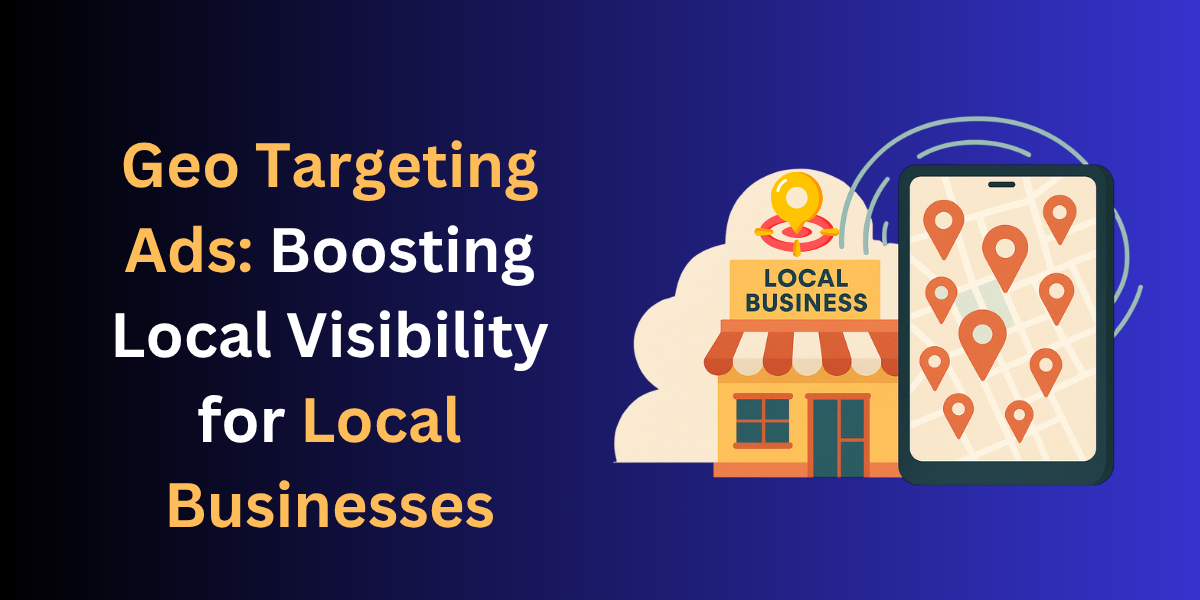Geo Targeting Ads: Boosting Local Visibility for Local Businesses
There is an ocean of digital noise clogging the Web in this era, and local businesses get just a bit more submerged in it; hence, precision tools are needed for their visibility. Geo Targeting Ads are a tool with a strategic advantage: promotional messages are served to users depending on their physical location. Thus, a cafe can target office workers living nearby, while a boutique may want to serve shoppers on weekends. Geo targeting serves ads just in the nick of time so that visibility, foot traffic, and conversion are enhanced.
What Is Geo Targeting Advertising?
Definition and Overview
Geo targeting advertising is an online marketing method where advertisements are tailored based on the geographical location of the prospective customer. This particular marketing technique allows the advertiser to pinpoint an audience for marketing in a particular city, neighborhood, or even out on a particular street corner, thus focusing their marketing efforts in a very effective and localized manner.
Types of Geo Targeting Techniques
GPS-based targeting:
Ad targeting is done on the use of GPS data from smartphones where the user can be within a defined geographical radius. Perfect for the situation of real-time location engagement.
IP address targeting:
It locates the user based on the IP address obtained from the device and is largely used in desktop targeting.
Beacon technology:
Bluetooth-powered beacons push ads conditioned upon location when within a certain distance from the user, for example in malls or stores.
Location-based social media ads:
Users are targeted based on these sites using check-ins or tagged locations on platforms such as Facebook or Instagram.
The Technology Behind GeoTargeting
Pinpointing an exact location of a user involves combining data from GPS, Wi-Fi signals, mobile towers, IP addresses, and device sensors. Real-time data processing by ad platforms ensures users are presented with ads relevant to their current location or that places they have recently been. The technology has evolved considerably from these traditional methods to achieve hyper-local granularity with geofencing, beacons, and refined data analytics.
Benefits of Geo Target Advertising for Local Stores
Increase Local Visibility and Footfall
Close-proximity advertising allows a spontaneous visit to be encouraged, particularly during peak hours or at events. Thus, ridiculous amounts of footfall are caused due to proximity-based advertisement.
Cost-Effectiveness and ROI
By aiming ads at users most likely to convert, paid geo targeting ensures ads are space-time specific and not mass blanket ads, therefore minimizing wastage and enhancing ROI.
Enhanced Customer Engagement
Relevant, personalized, location-aware messages stimulate customer interaction; truly, consumers are more likely to engage with ads that cater to their urgent needs.
Competitive Advantage
Local businesses have the ability to edge out their larger counterparts by enticing local clients with time-sensitive promotions and localized messaging.
Read More: Latest Digital Marketing Trends
Setting Up Effective Geo Targeting Campaigns
Defining Your Local Audience
Start with customer data analysis and identify the high-conversion areas. Consider foot traffic, demographics, and local events that would contribute to shaping your ideal local audience.
Selecting the Right Platforms
Google Ads:
Google’s geo focused on allows for radius targeting and place-primarily based keyword bidding, so your commercials display on the right time and at the proper location.
Facebook & Instagram:
These have awesome location-targeting options by zip code, city, or custom placement on the map. Perfect for visible brand storytelling and cell-first clients.
Other platforms:
Snapchat, TikTok, and Waze offer geo ad variants that really help appeal to younger, mobile-conscious users through short-form and map-integrated ads.
Creating Compelling Location-Specific Ads
Align the copy and visuals with local culture, language, and needs. Refer to landmarks, festivals, or weather to establish a strong local bond.
Tracking and Optimizing the Campaigns
Track ad analytics to monitor performance and engagement levels per location. Please update your geofence, budgets, and creatives based on real-time data and feedback.
Best Practices and Strategies to Achieve the Highest Possible Outcome:
Focus on High-Intent Users
Direct your ads toward people who are actively searching for products or services of the kind offered by your location. Since this method intends to generate leads, therefore upon conversion, the potential of earning revenue becomes obviously higher.
Geofencing and Radius Targeting
Create virtual barriers spherical your very very own locations or the ones of your competitors.
Integrate Offline Data with Online Campaigns
Use loyalty application facts, POS data, and in-store behavior information to refine on line geo targeting techniques. This will provide for better ad personalization.
Leverage Customer Feedback and Data
Find out through surveys or reviews what kinds of location-based offers appeal to them. Use that information to tweak your messages in the future that are geo or location-targeted.
Read More: How to Build High Quality Backlinks in 2025
Data Privacy, Ethical Considerations, and Compliance
Understanding User Privacy Regulations
Ensure that your activities are compliant with regulations such as GDPR, CCPA, and India’s DPDP. It is important to ask each individual for consent prior to tracing his physical location.
Responsible Use of Location Data
Use anonymized and aggregated data, wherever possible. Please avoid tactics that can make a customer feel that he or she is under a surveillance or uncomfortable.
Building Customer Trust
Sponsor full disclosure about the use of location data. Convince customers of the benefits that stem from location-based information like real-time offers or convenience.
Real-World Examples and Case Studies
Local Restaurant Chain Boosts Foot Traffic via Geo Targeted Ads
A regional food chain ran time-sensitive lunch ads targeting office workers within a 1km radius, resulting in a 25% increase in dine-in customers during weekdays.
Retail Store Uses Geofencing to Promote In-Store Promotions
A clothing store set up geofences around shopping malls and transit stops, offering flash discounts. Footfall rose 40% during weekends after campaign launch.
Service Providers Enhance Customer Engagement with Location-Specific Offers
A local salon targeted ads within 2km of its location offering discounted haircuts. The campaign saw a 3x increase in appointment bookings in 2 weeks.
Conclusion
Geo concentrated on commercials constitute a sport-converting strategy for neighborhood groups aiming to connect to nearby clients. From GPS-based targeting to geofencing, these techniques empower businesses to optimize their marketing spend and deliver highly relevant content. By focusing on proximity, user behavior, and local intent, businesses can drive meaningful engagement and tangible results. However, success requires more than just setting a location parameter—it demands smart audience insights, compelling creatives, and ongoing campaign optimization.
For businesses aiming to maximize the power of geo targeting, partnering with a seasoned digital marketing agency in Surat like Metaloop Marketing can make a world of difference. Metaloop specializes in developing customized geo targeting strategies that fuse advanced tools with deep local market insights. This ensures your brand connects effectively with nearby audiences and stays top-of-mind for customers in your area. Whether you’re a retail store, service provider, or franchise, Metaloop’s expertise helps drive foot traffic and boost local engagement.



Write a Comment